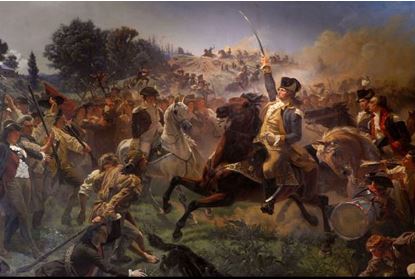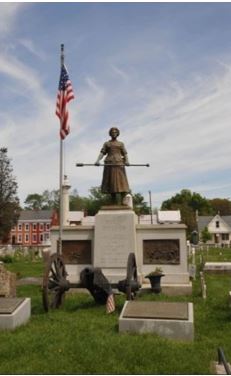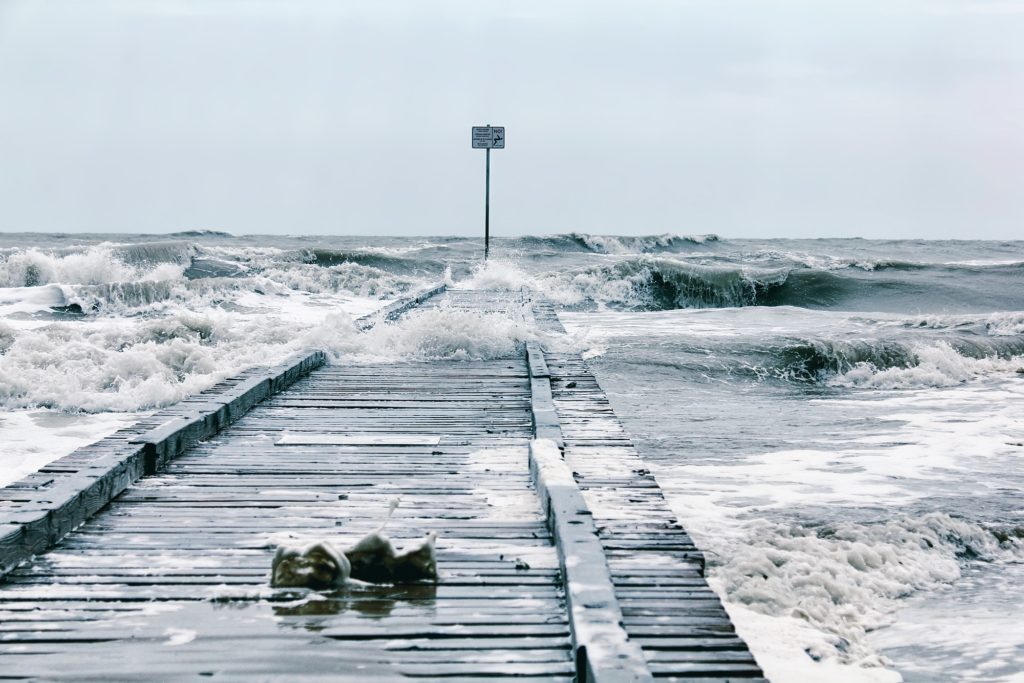A couple of nights ago my wife and I were getting caught up with the latest season of Outlander on Starz. The story deals with a young Scottish Highlander from the 1740s who falls in love with a British woman from the 1940s who accidentally became a time traveler. Later in the story, the couple are living in North Carolina as the Revolutionary War began. This series has been remarkably accurate historically but more so in the early seasons. To shorten this up, the main characters get involved in the war on the side of the American rebels. One episode featured the Battle of Monmouth. Since I have read so much about the Revolutionary War, I was familiar with that battle being fought during an intense heat wave and a legendary female character arose from it. The Outlander episode didn’t refer to the stifling heat nor the historical female figure. So, here is that story.
On June 28, 1778, the Continental Army took on a regiment of British soldiers and Hessian mercenaries at Monmouth, New Jersey. The battle itself was fought amidst intense heat and unbearable humidity. The battle itself wasn’t very noteworthy but a notable figure emerged from it. It was a lady and a feisty one at that who became known as Molly Pitcher.
Prelude To Battle
The Continental Army under George Washington received a big shot in the arm in February of 1778 when France signed on to join the American army against the British. The victory of our forces at Saratoga went a long way toward making this happen.
In addition, General Washington summoned a Prussian officer Baron Von Stuben to drill the Continental Army and teach them proper methods of battle. The had been some criticism of the lack of discipline in Washington’s army and setbacks at Philadelphia didn’t help matters. There were even calls for replacing Washington as commander. With France in the mix, King George III wanted British troops in Florida and the West Indies.
The British commander, Sir Henry Clinton was faced with a shortage of men so he decided to abandon Philadelphia and shore up his forces around New York. On June 18, 1788, Clinton ordered his men to move up from Philadelphia to New York. Clinton later changed his mild and sent the troops toward Sandy Hook, New Jersey. They would then take boats up to New York.
Meanwhile, Washington’s Army as camped at Valley Forge. His forces continued to be drilled and trained by Baron von Stuben. Washington left Valley Forge and Hopewell, New Jersey, on June 23rd. There, he held a council of war. Washington knew about the British plan and wanted to attack their forces on the rear flank.
So, a force of 5,000 was set and ready to take on British forces to hinder their move to New York. Major Charles Lee was given the command of the Continental forces.
Battle of Monmouth
For several days, the heat was building over the East Coast. most likely from a high-pressure ridge. June 27th was very hot and humid across southern New Jersey and there were reports of afternoon thunderstorms.
On June 28th, Washington received information that the British had begun their move. Washington ordered Lee to strike the ank of the enemy. The attack on the British was haphazard and ineffective. An enraged Washington relieved Lee of his command and took control of his forces against the British.
This painting by Emanuel Leutze shows George Washington rallying his troops at The Battle of Monmouth on June 28, 1778. Image Credit- Public Domain.
Molly Pitcher
I’m going to leave the battle and digress for a bit to get to the crux of this tale. Quite often when writing these stories, I knew nothing about them ahead of time it was different and I wanted to tell the part of the story that the Outlander episode didn’t.
I have often traveled up Interstate 81 toward my hometown in Upstate New York from either northern Virginia of Georgia. When you cross the border from Maryland into Pennsylvania you quickly pass Exit 3 which says Molly Pitcher Highway. I figured that if they name a highway after someone then they must have done something noteworthy. So I researched Molly Pitcher and I have known about the story for a long time.
This photo was taken on Interstate 81 in southern Pennsylvania showing the exit for Molly Pitcher Highway. Photo Credit-Wikimedia Commons -Public Domain.
Mary Ludwig was born in Philadelphia, Pennsylvania, on October 13, 1744. She never attended school but it was common for women to have no formal education but that was not uncommon for the time.
Mary eventually married William Hays who was from Carlisle, Pennsylvania. In 1777 William Hays enlisted in the Continental Army. Later that year, Mary joined her husband at Valley Forge. There were many women, like Martha Washington, who would wash the soldiers clothing and care for the sick and dying. Several of them were brave enough to provide water for the soldiers during battle. water was used for drinking and for cleaning weaponry.
This leads us back to the Battle of Monmouth. William Hays was on the battlefield, operating a cannon and Mary was there, as well. As mentioned earlier, the heat was intense. There were some reports that the temperature approached or even exceeded 100 degrees.
Since there were thunderstorms the day before, we know that humidity levels were high. The heat index was probably over 110 degrees. Soldiers were collapsing from heat exhaustion and many died on that day from the heat rather than from weaponry.
Others became extremely ill and couldn’t continue. The heavy woolen uniforms that the soldiers wore didn’t help matters. There were some recollections that the soldiers were ordered to take off their coats. The extreme conditions had a deadly effect on horses, as well. It has been said that George Washington’s horse collapsed and died.
In the midst of the battle, Mary found a spring and filled pitchers of water which she brought to the heat-weary soldiers. I don’t know the reason but during that period of time, many women named Mary were given the nickname “Molly”. Across the eld of battle, some of the soldiers were crying out Molly pitcher ! … Molly-pitcher! That is where legend tells us she got that name.
This painting depicts Molly Pitcher providing aid to the Continental Army troops at The Battle of Monmouth on June 28, 1788. (note the lack of uniforms). Image Credit-Unknown.
Her husband, William, collapsed from heat exhaustion. It was said that Mary dropped her pitchers and proceeded to her husband’s cannon and began to load and fire. It seems that Mary was what I would call a “sassy lassie”.
A cannon shot from the British passed between her legs and carried away the lower part of her petticoat. It was said that Mary then exclaimed: “I’m lucky that it didn’t pass any higher … just think what that would have taken.”
As for the battle, Washington was able to take control of the situation. The training and discipline that was instilled by von Stuben allowed the Continental Army to fight the British to a standoff. As the evening continued the fighting stopped. The British were able to get away to Sandy Hook the next day as the Continental forces were too exhausted to fight on.
The battle gave the Continental Army more credibility and any observers acknowledged the increased discipline that they fought with.
Aftermath
Because of her heroism in the Battle of Monmouth, Washington bestowed a warrant as a non commissioned officer upon Mary Hays/Molly Pitcher. She was often called “Sergeant Molly” in the years ahead.
William survived the battle and after the war, Mary and William moved to Carlisle, Pennsylvania.
They had a son named Johannes. William died in 1786. he did leave his wife a good bit of land.
After that things didn’t go so well for “Molly”. In 1793 she married a man named John McCauley. He was said to have a violent temper and he was abusive to Molly. McCauley also encountered financial difficulty and Mary had to sell 200 acres of her inherited land for a mere 30 dollars. Around 1810, McCauley disappeared and was never heard from again.
“Molly” continued to live in Carlisle performing various jobs for hire such as cleaning and painting houses and caring for children and sick people. She was often seen in town wearing a striped skirt, wool stockings, and a cap. People generally liked “Molly” but it was said that she “cursed like a soldier.”
On February 21, 1822, the Commonwealth of Pennsylvania gave ‘Molly” an annual pension of 40 dollars (about 1,100 in 2025 dollars).
This photo shows the grave site and statue of Molly McCauley in Carlisle, Pennsylvania. Photo Credit-Wikipedia-Public Domain.
Mary Hays McCauley died on January 22, 1832. She is buried in the Old Graveyard in Carlisle under the name Molly McCauley. A statue of “Molly Pitcher” stands with a cannon in the cemetery.






